French colonial architecture has profoundly shaped Hanoi’s urban landscape, blending European styles with Vietnamese elements. SIXT.VN offers tours that showcase this unique architectural heritage, ensuring a memorable exploration of Hanoi’s historical sites. Discover Hanoi’s charm through its stunning colonial buildings, reflecting a fusion of cultures and styles.
1. What is the Hanoi Opera House and How Does it Reflect French Influence?
The Hanoi Opera House, located at 1 Trang Tien Street, Hoan Kiem District, Hanoi, stands as a prime example of French architectural influence. Built between 1901 and 1911 by French architects V. Harley and Broyer, it was inspired by the Paris Opera style, representing a blend of French neoclassical architecture with Gothic and European Renaissance elements. The Hanoi Opera House is a testament to the fusion of French architectural styles with local adaptations, and it’s considered one of the most famous landmarks in Hanoi.
The Opera House showcases a mix of architectural styles, incorporating neoclassical design with Gothic and Renaissance details. The use of high-quality materials such as Italian marble for the floors, French murals on the ceilings, and bronze chandeliers exemplifies the opulence of European architecture. According to historical records, the Opera House was designed to serve as a cultural hub, mirroring the grandeur of European opera houses. Its construction marked a significant step in introducing European artistic and cultural values to Vietnam. The building’s design includes a grand staircase, ornate balconies, and a spacious auditorium, all reflecting the architectural norms of the time. The exterior is adorned with intricate carvings and sculptures, showcasing the artistic skills of both French and Vietnamese craftsmen.
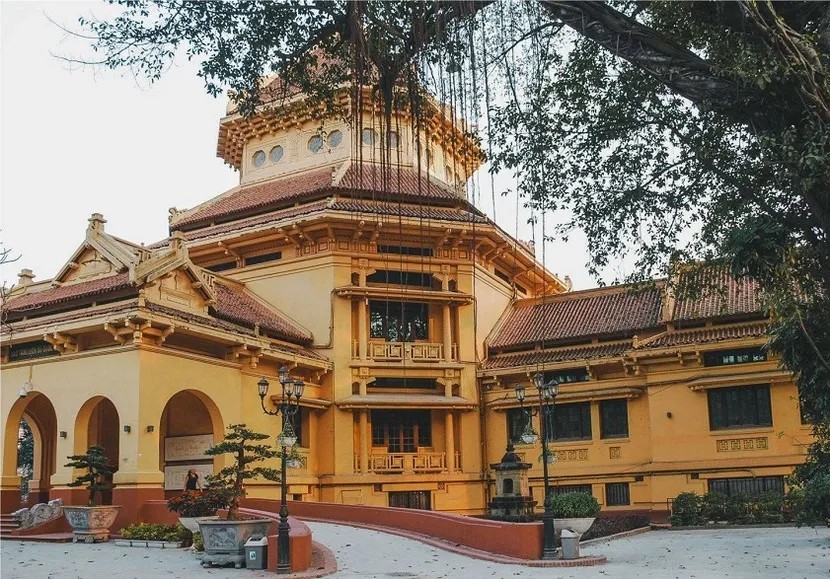 Hanoi Opera House reflecting French architecture
Hanoi Opera House reflecting French architecture
2. How Does the Vietnam National Museum of History Showcase French Colonial Architecture?
The Vietnam National Museum of History, with addresses at 1 Trang Tien Street and 216 Tran Quang Khai, Hoan Kiem, Hanoi, beautifully exemplifies French colonial architecture. Constructed in 1926 and opened in 1932, the building showcases a blend of French architectural styles adapted to the local climate and culture. It was later taken over by the Vietnamese government in 1958 and opened to the public on September 3 of the same year.
The museum displays the history of Vietnam, spanning from its earliest days around 300,000 to 400,000 years ago, up until the August Revolution of 1945. It houses a collection of around 200,000 artifacts and documents related to the cultural history of Vietnam, including nearly 110,000 antiquities and 19 national treasures.
The building’s design incorporates elements of French colonial architecture, such as symmetrical facades, arched windows, and decorative moldings. The use of local materials and Vietnamese motifs in the ornamentation reflects an adaptation of European styles to the local context. The museum’s architecture serves as a historical backdrop, enhancing the visitor’s experience as they explore Vietnam’s rich heritage. The layout of the museum is designed to guide visitors through different periods of Vietnamese history, with exhibits arranged chronologically. The building’s structure includes spacious galleries and well-lit display areas, providing an optimal environment for showcasing historical artifacts.
3. What Makes the Sofitel Legend Metropole Hanoi a Notable Example of French Colonial Influence?
The Sofitel Legend Metropole Hanoi, located at 15 Ngo Quyen, Hoan Kiem, Hanoi, is renowned as the first and oldest 5-star hotel in Hanoi, built in 1901 by French investors André Ducamp and Gustave-Émile Dumoutier. Its neoclassical structure and subsequent restoration in 1990 have preserved its colonial-era charm, featuring a classic Citroën parked at the front, dark wood-paneled lobbies, and luxurious furniture. The Sofitel Legend Metropole Hanoi remains a symbol of French elegance and historical significance in Hanoi.
The hotel’s architecture embodies French colonial design, characterized by its elegant facade, symmetrical layout, and ornate detailing. The use of high-quality materials such as marble, wood, and wrought iron reflects the opulence of the era. The hotel’s design also incorporates elements of Vietnamese culture, creating a unique blend of Eastern and Western aesthetics. The Metropole Hanoi has hosted numerous historical figures and celebrities, adding to its prestige and allure. According to historical accounts, the hotel played a significant role in Hanoi’s social and cultural life during the French colonial period. Its grand ballrooms and dining areas were the venues for important events and celebrations.
4. What is the Significance of the Government Guest House in Hanoi’s French Architectural History?
The Government Guest House, situated at 12 Ngo Quyen – 2 Le Thach, Hoan Kiem, Hanoi, is a significant building that exemplifies French architectural style. Built in 1918 on the site of the old Bao An pagoda, this large yellow building, now adorned with the Vietnamese flag, once served as the residence of the French governor of Tonkin. After the August Revolution of 1945, it became the government headquarters of the Democratic Republic of Vietnam.
The Government Guest House showcases elegant French architectural elements, including its symmetrical facade, arched windows, and decorative moldings. The building’s design reflects the grandeur and authority of the French colonial administration. Its transformation into the government headquarters of Vietnam symbolizes the country’s transition from colonial rule to independence. The Guest House has been the site of numerous important political events and diplomatic meetings, highlighting its ongoing significance in Vietnam’s history. The building’s architecture includes spacious offices, reception areas, and meeting rooms, designed to accommodate the needs of the government.
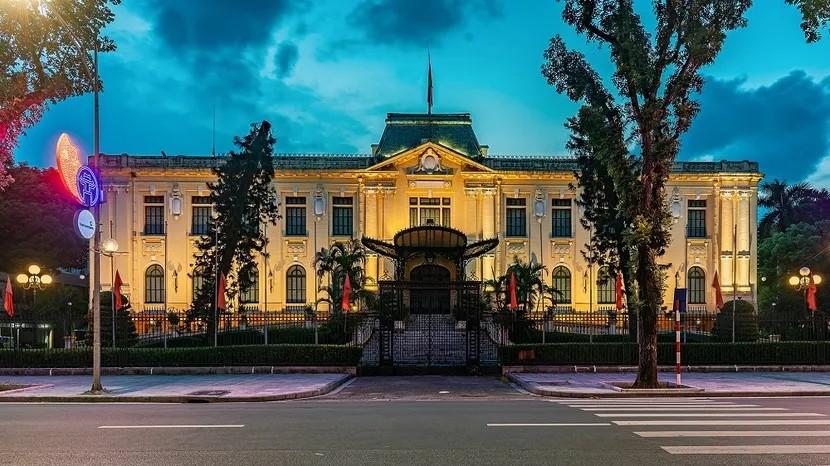 Government Guest House showcasing French architecture
Government Guest House showcasing French architecture
5. How Does the State Bank of Vietnam Represent Art Deco Style in Hanoi?
The State Bank of Vietnam, located at 49 Ly Thai To, Trang Tien, Hoan Kiem, Hanoi, was originally built in 1928 as the Indochina Bank of France. Redesigned in the Art Deco style in the early 1930s, its prime location, open façade, and bright interiors make it a perfect example of Art Deco architecture in Hanoi.
The building’s Art Deco design is characterized by geometric shapes, streamlined forms, and decorative motifs inspired by industrial and modern themes. The use of high-quality materials such as marble, granite, and metal enhances its aesthetic appeal. The State Bank of Vietnam’s architecture reflects the optimism and progressiveness of the Art Deco movement. The building’s design includes large windows, allowing natural light to flood the interior spaces. The facade is adorned with intricate carvings and sculptures, showcasing the artistic skills of the period.
6. Why is St. Joseph’s Cathedral Considered a Prime Example of Gothic Architecture in Hanoi?
St. Joseph’s Cathedral, located at 40 Nha Chung Street, Hang Trong, Hoan Kiem, Hanoi, is the oldest cathedral in Hanoi. Constructed starting in 1884 on the grounds of the Bao Thien Pagoda and completed in 1888, it is one of the earliest architectural works built by the French colonial government. As a typical example of Gothic architecture in Vietnam, its interior features high stained glass windows and tall domes, surrounded by paintings of Jesus Christ.
The cathedral’s Gothic design is evident in its pointed arches, ribbed vaults, and soaring spires, all of which create a sense of verticality and grandeur. The stained glass windows depict biblical scenes and allow colorful light to filter into the interior, creating a serene atmosphere. St. Joseph’s Cathedral is a significant religious and cultural landmark in Hanoi, serving as a place of worship and a symbol of the city’s history. The cathedral’s architecture includes intricate carvings, sculptures, and other decorative elements that enhance its aesthetic appeal. The building’s design reflects the architectural norms of European cathedrals, adapted to the local context.
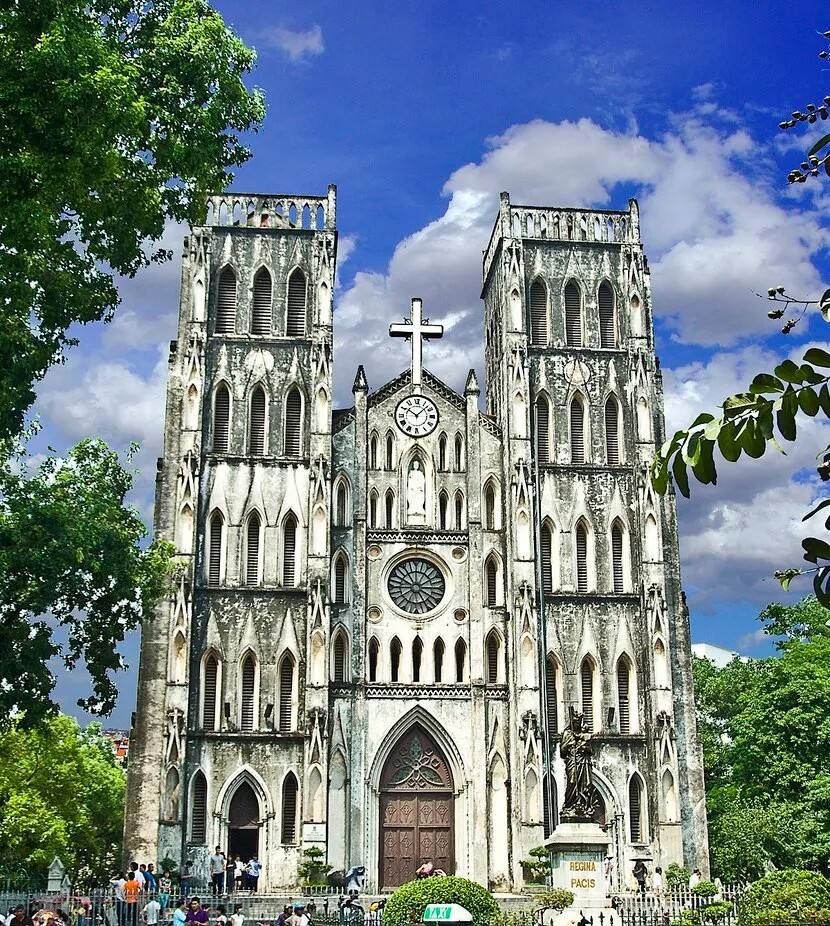 St Joseph Cathedral Hanoi – French Colonial Architecture
St Joseph Cathedral Hanoi – French Colonial Architecture
7. How Does the Presidential Palace Reflect Neoclassical Architecture in Hanoi?
The Presidential Palace, situated at 2 Hung Vuong, Ngoc Ho, Ba Dinh, Hanoi, showcases neoclassical architecture. Built over six years from 1900 to 1906, it once served as the living and working place of the Indochina governor. In 1945, it was renamed the Presidential Palace and used for national ceremonies and entertaining diplomats and foreign leaders.
The palace’s neoclassical design is characterized by its symmetrical facade, grand columns, and balanced proportions. The use of high-quality materials such as marble and stone reflects the opulence and authority of the French colonial administration. The Presidential Palace is a significant historical and political landmark in Hanoi, symbolizing the country’s transition from colonial rule to independence. The building’s architecture includes spacious reception halls, offices, and meeting rooms, designed to accommodate the needs of the government. The exterior is adorned with intricate carvings and sculptures, showcasing the artistic skills of the period.
8. What French Architectural Elements Can Be Found in the Vietnam Military History Museum?
The Vietnam Military History Museum, located at 28A Dien Bien Phu, Hanoi, was built on July 17, 1956, and exemplifies French colonial architecture. This two-story museum includes both outdoor and indoor exhibits, containing thousands of artifacts, photos, maps, and scale models of past wars.
The museum’s French colonial design is characterized by its symmetrical facade, arched windows, and decorative moldings. The building’s architecture reflects the influence of French administrative buildings of the period. Its transformation into a military history museum symbolizes Vietnam’s focus on preserving and showcasing its military heritage. The museum’s exhibits provide visitors with a comprehensive understanding of Vietnam’s military history, from ancient times to the present day. The building’s design includes spacious galleries, allowing for the display of large artifacts and exhibits.
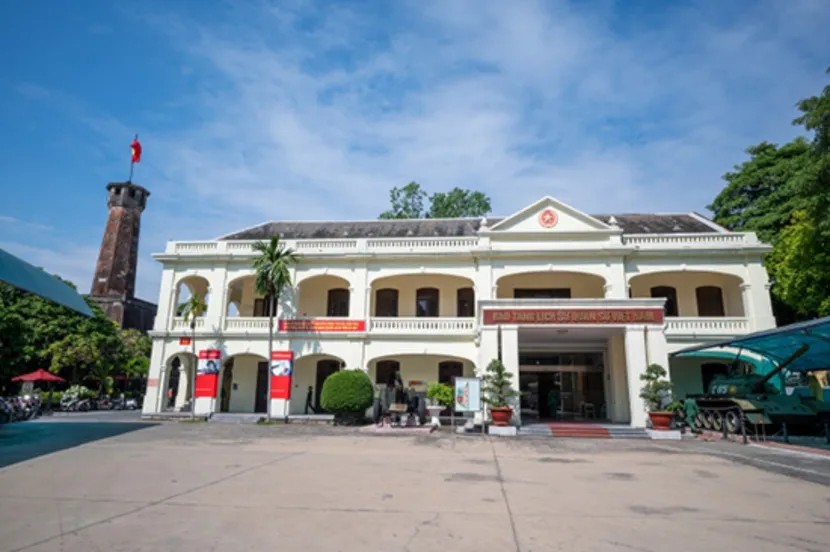 Vietnam Military History Museum featuring French architecture
Vietnam Military History Museum featuring French architecture
9. How Does Hoa Lo Prison Reflect French Colonial Architectural Design?
Hoa Lo Prison, located at 1 Hoa Lo, Tran Hung Dao, Hoan Kiem, Hanoi, was built from 1886 to 1901 by the French colonialists in Indochina for political prisoners. Later, it was used by North Vietnam for American prisoners of war during the Vietnam War. Known to the French colonialists as Maison Centrale (Central Prison) and ironically called the Hanoi Hilton by American prisoners, the prison’s structure reflected the colonial architectural design of the time.
During the French colonial period, Hoa Lo Prison featured 4-meter-high stone walls, 0.5 meters thick, reinforced with electric steel wires, and watchtowers at the four corners.
The prison’s design includes thick stone walls, reinforced with steel, and watchtowers strategically placed to monitor the inmates. The use of heavy materials and imposing structures reflects the intention to create a secure and intimidating environment. Hoa Lo Prison stands as a grim reminder of the French colonial period and the suffering endured by political prisoners. The prison’s architecture includes dark and cramped cells, designed to isolate and dehumanize the inmates. The building’s structure reflects the architectural norms of prisons of the time, adapted to the local context.
10. How Does Dong Xuan Market Embody French Architectural Styles?
Dong Xuan Market, located at 15 Cau Dong, Dong Xuan, Hoan Kiem, Hanoi, is one of the oldest and largest markets in Hanoi’s Old City. Built in 1889 in the French style, it stands as a symbol of Hanoi’s tradition and pride. Visitors can find almost anything from souvenirs and clothes to household items and food at cheap prices, making it a must-visit destination.
The market’s French architectural design is characterized by its large scale, symmetrical layout, and use of durable materials such as brick and stone. The building’s architecture reflects the influence of French commercial buildings of the period. Dong Xuan Market is a bustling hub of activity, where locals and tourists alike come to shop, eat, and experience the vibrant atmosphere of Hanoi. The market’s architecture includes spacious halls, allowing for the display of a wide variety of goods. The building’s structure reflects the architectural norms of markets of the time, adapted to the local context.
 Dong Xuan Market showcasing French architecture
Dong Xuan Market showcasing French architecture
11. What Makes Long Bien Bridge a Significant French Colonial Structure in Hanoi?
Long Bien Bridge, located in Ngoc Thuy, Long Bien, Hanoi, was officially built from 1899 to 1902 under Indochina Governor-General Doumer. While it is clearly a French colonial structure, with the participation of about 40 French engineers and experts, its completion by over 3,000 Vietnamese workers using local materials makes it an achievement of the Vietnamese people.
Initially named after Paul Doumer, the bridge was renamed Long Bien Bridge after the liberation of the capital in 1954. Its location near the Imperial Citadel of Thang Long gives it its name, resembling a dragon flying over the Red River.
The bridge’s design includes long spans, sturdy piers, and a steel framework, reflecting the engineering expertise of the French. The use of local materials and Vietnamese labor in its construction symbolizes the collaboration between the French and Vietnamese during the colonial period. Long Bien Bridge is a significant transportation and historical landmark in Hanoi, connecting the city center with the eastern districts. The bridge’s architecture includes walkways for pedestrians and railway tracks for trains, reflecting its importance as a transportation artery. The structure has been repaired and renovated several times throughout its history, but it has retained its original design and character.
12. What is the Historical Significance of Hang Dau Water Tank and its French Architectural Design?
Hang Dau Water Tank, located in Quan Thanh, Hoan Kiem, Hanoi, was built in 1894, before the Long Bien Bridge. It supplied water to local people and Western soldiers in the Hanoi Old Quarter. Resembling an ancient fortress with a three-tiered cylinder 19 meters in diameter and 25 meters high, it has remained a special scenic spot.
Since 1954, the water tank has been abandoned but kept its original shape, undergoing renovation in early April 2010. Today, it stands as a testimony to a historical period in Hanoi.
The water tank’s design includes a large cylindrical structure, made of brick and stone, with a capacity to hold a significant amount of water. The use of durable materials and sturdy construction reflects the intention to create a reliable water supply for the city. Hang Dau Water Tank is a significant historical and architectural landmark in Hanoi, symbolizing the city’s infrastructure development during the French colonial period. The water tank’s architecture includes a tower-like structure, providing a vantage point for monitoring the water level and distribution. The structure has been preserved as a historical monument, attracting tourists and locals alike.
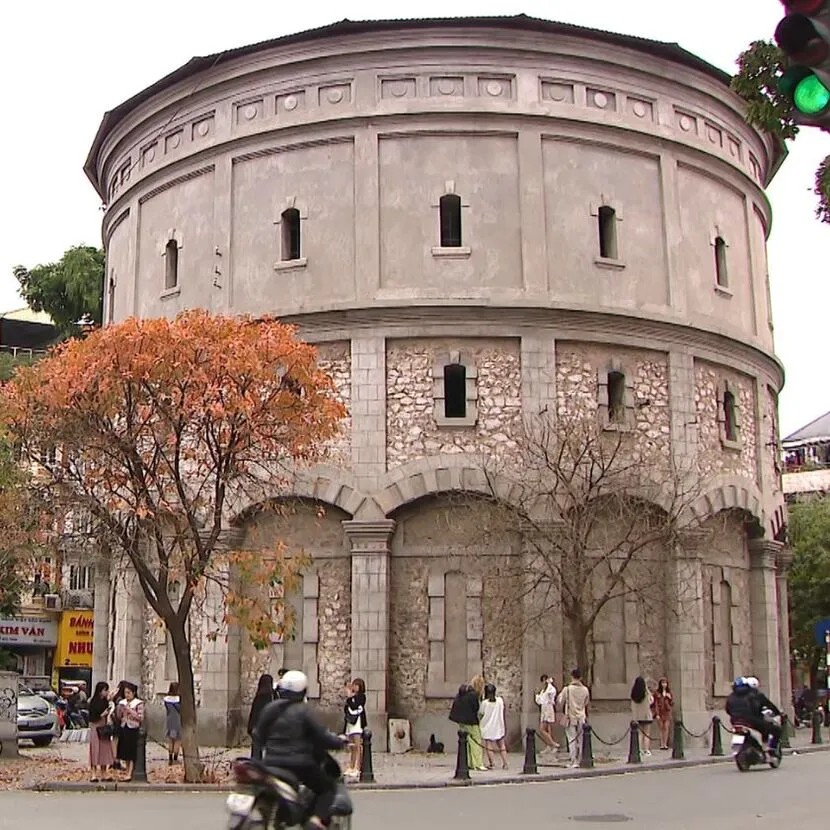 Hang Dau Water Tank – Hanoi's French Architecture
Hang Dau Water Tank – Hanoi's French Architecture
13. How Does the Ministry of Foreign Affairs Building Showcase Indochine Architectural Style?
The Ministry of Foreign Affairs, located at 1 Ton That Dam, Ba Dinh, Hanoi, was designed by French architect Ernest Hebrard. The building showcases a distinctive Indochine style that blends Eastern traditions and Western modernity.
Originally the headquarters of Indochina’s Ministry of Finance, it became the headquarters of Vietnam’s Ministry of Foreign Affairs on October 3, 1945, and was recognized as a national monument in August 2016. Nearly 100 years old, it remains one of the rare examples of French colonial architecture in Hanoi.
The building’s Indochine design is characterized by its blend of French and Vietnamese architectural elements, creating a unique and harmonious aesthetic. The use of local materials and Vietnamese motifs in the ornamentation reflects an adaptation of European styles to the local context. The Ministry of Foreign Affairs is a significant political and historical landmark in Hanoi, symbolizing Vietnam’s role in international diplomacy. The building’s architecture includes spacious offices, reception areas, and meeting rooms, designed to accommodate the needs of the government. The exterior is adorned with intricate carvings and sculptures, showcasing the artistic skills of both French and Vietnamese craftsmen.
14. What Unique Architectural Features Define Cua Bac Church?
Cua Bac Church, situated at 56 Phan Dinh Phung, Hanoi, is another project by French architect Ernest Hébrard and a Roman Catholic church belonging to the Archdiocese of Hanoi.
Built between 1925 and 1931, Cua Bac Church features unique decorative elements in rectangular shapes, combining Asian-European architectural styles. Its asymmetrical architecture, completely different from other large churches of the period, makes it one of the oldest and most beautiful churches in Vietnam.
The church’s design includes a blend of French and Vietnamese architectural elements, creating a unique and harmonious aesthetic. The use of local materials and Vietnamese motifs in the ornamentation reflects an adaptation of European styles to the local context. Cua Bac Church is a significant religious and architectural landmark in Hanoi, serving as a place of worship and a symbol of the city’s cultural diversity. The church’s architecture includes stained glass windows, intricate carvings, and other decorative elements that enhance its aesthetic appeal. The building’s design reflects the architectural norms of European churches, adapted to the local context.
 Cua Bac Church showing French architecture
Cua Bac Church showing French architecture
15. How Does the University of Science, Vietnam National University, Hanoi, Reflect Indochine Architectural Style?
The University of Science, Vietnam National University, Hanoi, located at 19 Le Thanh Tong, Phan Chu Trinh, Hoan Kiem, Hanoi, was also designed by French architect Ernest Hébrard. Built between 1923 and 1926 in the Indochine architectural style, it showcases Asian-European influences.
Originally named Indochina University, it has changed its name several times throughout its history, becoming Vietnam National University in 1945 and Hanoi University in 1956. In 1993, the university’s name was officially changed to Vietnam National University with the merger of 3 other smaller universities.
The university’s Indochine design is characterized by its blend of French and Vietnamese architectural elements, creating a unique and harmonious aesthetic. The use of local materials and Vietnamese motifs in the ornamentation reflects an adaptation of European styles to the local context. The University of Science is a significant educational and architectural landmark in Hanoi, symbolizing the city’s commitment to academic excellence. The building’s architecture includes spacious classrooms, laboratories, and libraries, designed to accommodate the needs of students and faculty. The exterior is adorned with intricate carvings and sculptures, showcasing the artistic skills of both French and Vietnamese craftsmen.
Planning Your Hanoi Trip with SIXT.VN
Are you ready to explore the architectural wonders of Hanoi? SIXT.VN offers comprehensive travel services to make your trip seamless and memorable:
- Customized Itineraries: Tailored to your interests and schedule.
- Airport Transfers: Safe and convenient transportation.
- Hotel Bookings: A wide range of options to fit your budget.
- Sightseeing Tours: Expert-led tours of Hanoi’s iconic landmarks.
- Flight Bookings: Hassle-free booking of flights at competitive prices.
Contact SIXT.VN Today!
- Address: 260 Cau Giay, Hanoi, Vietnam
- Hotline/Whatsapp: +84 986 244 358
- Website: SIXT.VN
Explore Hanoi’s French colonial architecture with SIXT.VN and experience the best of Vietnamese hospitality. Book your tour today and create unforgettable memories!
FAQ: French Colonial Architecture in Hanoi
1. What defines French colonial architecture?
French colonial architecture is defined by a blend of European architectural styles, such as neoclassical, Gothic, and Art Deco, adapted to the local climate and culture of the colonies. These buildings often feature symmetrical facades, arched windows, decorative moldings, and the use of local materials.
2. Why is French colonial architecture significant in Hanoi?
French colonial architecture is significant in Hanoi because it represents a unique fusion of Eastern and Western cultures, reflecting the historical period when Vietnam was under French rule. These buildings contribute to Hanoi’s distinctive urban landscape and serve as reminders of the city’s rich history.
3. Can I visit these French colonial buildings?
Yes, many of the French colonial buildings in Hanoi are open to the public as museums, hotels, or government buildings. Some may require tickets or guided tours, while others can be viewed from the outside.
4. How did the French influence Vietnamese architecture?
The French influenced Vietnamese architecture by introducing European architectural styles, construction techniques, and materials. They also trained Vietnamese architects and craftsmen, who then incorporated these elements into local building traditions.
5. What are some common features of French colonial buildings in Hanoi?
Common features of French colonial buildings in Hanoi include symmetrical facades, arched windows, decorative moldings, high ceilings, and the use of local materials such as brick, stone, and wood.
6. Are there any tours that focus on French colonial architecture in Hanoi?
Yes, SIXT.VN offers tours that focus on French colonial architecture in Hanoi. These tours provide expert-led explorations of the city’s iconic landmarks, offering insights into their history and architectural significance.
7. How has French colonial architecture been preserved in Hanoi?
French colonial architecture has been preserved in Hanoi through restoration efforts, adaptive reuse of buildings, and recognition of these structures as historical and cultural landmarks.
8. What is the Indochine architectural style?
The Indochine architectural style is a blend of French and Vietnamese architectural elements, creating a unique and harmonious aesthetic. It is characterized by the use of local materials, Vietnamese motifs, and adaptations of European styles to the local climate and culture.
9. How can I book a tour to see French colonial architecture in Hanoi with SIXT.VN?
You can book a tour to see French colonial architecture in Hanoi with SIXT.VN by visiting their website at SIXT.VN or contacting them via hotline/WhatsApp at +84 986 244 358.
10. What other attractions can I visit in Hanoi besides French colonial buildings?
Besides French colonial buildings, you can visit other attractions in Hanoi such as Hoan Kiem Lake, the Old Quarter, temples, pagodas, and museums showcasing Vietnamese history and culture.



